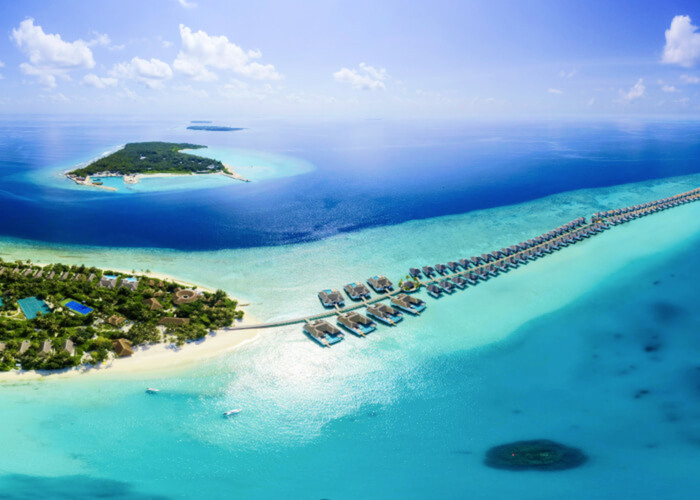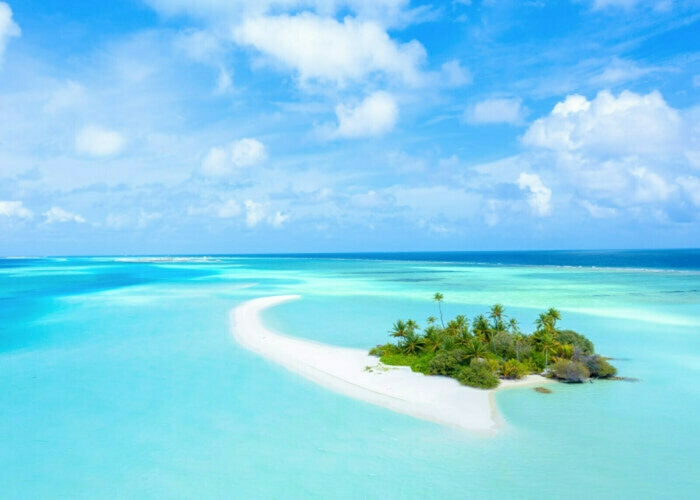Maldives: when to go • weather by season, budget windows, practical tips
When is it best to fly to the Maldives? The question sparks debate because air and sea temperatures on these Indian Ocean islands hover around +30 °C all year, yet travelers’ priorities differ: some dream of bright sun and diving among corals in calm, clear water; others worry about sunburn, prefer waves, and plan to enjoy surfing. There are also those who want the most budget-friendly holiday on paradise beaches with palms and white sand.
It’s easy to remember: the peak tourist season on these fairy-tale islands begins just as the familiar seasons in Europe and the Mediterranean wind down. When we have cold, snow, and rain, the Maldives welcome travelers with bright sunshine and serene rest. And when our resort calendar is in full swing, their season of winds and rains begins. Even then the islands greet visitors — it’s golden time for wave-lovers and surfers, and hotels delight with the deepest accommodation discounts.
Maldives weather: quick overview
The Maldives’ location gives them a tropical climate with warm, humid weather year-round: they sit in the Indian Ocean near the Equator (which even crosses the republic’s south). The archipelago spans 1,000+ coral islands, around 200 inhabited. Atolls are ringed by vivid blue lagoons — ideal for diving and a magnet for travelers worldwide.
Even so, the “coral state” splits into two monsoon periods: the dry season from November to April, when the iruvai blows and weather is clear and calm, and the wet season, when the hulhangu prevails.
When is the rainy season in the Maldives?
The Maldives’ rainy season — the hulhangu — runs May to September. May marks the transition; true downpours settle in by June. From September, rainfall tapers off and the long-awaited dry season begins.
Maldives weather by month
Winter in the Maldives — paradise mode
December opens peak season: warm and sunny days, air around +29 °C, showers are rare and brief. One of the best times to visit — bright sun and warm ocean. If you want New Year’s in a true tropical paradise, the Maldives are ideal.
January is premium-priced: rates that jumped for Christmas/New Year rarely drop before month-end. Weather stays dry and comfy: air +25…+29 °C, lagoons warm, minimal rainy days. Hotels roll out their best for romance and underwater adventures.
February mirrors January: sun-filled days and tropical ease; air and water roughly +27 °C. It’s typically near-windless — perfect for beach time and diving: crystal-clear, low-swell water to enjoy coral gardens and marine life.
Beyond diving, conditions suit island sightseeing: natural highlights of Ari Atoll, Baa Atoll (UNESCO Biosphere Reserve), Hanimaadhoo Reef, the Blue Lagoon of Vaavu, and Kuda Rah reef. Popular stops include Maafushi, Biyadhoo Reef, Vabbinfaru, and Dhigufinolhu. Shopping in the capital Malé is memorable. Do buy coral/pearl jewelry only from licensed stores and keep receipts (for smooth customs). Remember the Maldives are a Muslim country — dress modestly on local islands and in mosques.
Spring — the last stretch of the dry season
March is excellent for beach time, snorkeling, excursions, and barefoot sunset walks on white sands. Clear days; air up to +32 °C — clean water and gentle sun.
April stays warm, but humidity rises late-month and first showers can roll through. Still, April is the last dry-season month — a great moment to catch sunny spells. Islands are lush; most showers fall at night; evening breezes make strolls especially pleasant.
May brings the first signs of the hulhangu monsoon. It’s a shoulder month: sunny windows are possible, but rains become frequent. Seas get livelier — a plus for surfers; serenity-seekers should be ready for storms and downpours.
Summer — wet-season dynamics
June is fickle — among the wettest months: prolonged squalls and winds that raise surf. Air remains high (~+30 °C) and rainy stretches alternate with short sunny breaks. Adrenaline fans relish it.
July stabilizes as the monsoon eases; many showers come at night. Air sits around +29…+30 °C. Good for compromise-minded travelers: expect some wind/rain, but also clear days — plus quieter resorts.
August is mixed: brief showers, yet sun increasingly takes center stage. It’s prime to spot marine life — giant manta rays actively migrate across Baa and Raa atolls.
Autumn — the glide back into peak season
September stays temperamental: a shoulder-season month with storms and strong winds. Air near +28 °C, humidity trending down. Consider drier atolls like Haa Alifu or Addu.
October settles: fewer showers, air ~+28 °C. Resorts prep for peak season, yet pleasant discounts still linger.
November kicks off the velvet season. Rains recede, air and water feel delightful, seas calm, nature in full flourish. Resorts fill again — a very popular window for beach holidays.
When is it cheapest to fly to the Maldives?
If you want to save, look to shoulder periods — late April and early November. April still brings plenty of sun, and late October/early November already offers clear days; wet-season discounts can trim costs substantially.
From May to September, the strongest sales usually apply: resorts compete with Europe, Türkiye, and Egypt even in the rains, cutting accommodation and activity prices hard.
Don’t skip early-booking deals (months ahead) or genuine last-minute offers just before departure — savings of 10–30% off standard rates are common.
Now that you know the Maldives’ weather and seasonal nuances, all that’s left is picking the moment that fits you. Peak or off-season, the Maldives always deliver calm, beauty, and uniquely memorable escapes. Start plotting your perfect trip today!
Ready for an exotic Maldives break? See when conditions are best and book your package from Chișinău or Bucharest right now — make it comfy and unforgettable!
Direct line: +(373) 22 844 744


 Enter
Enter




